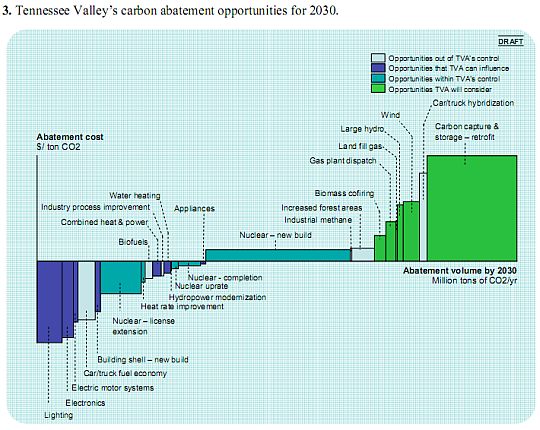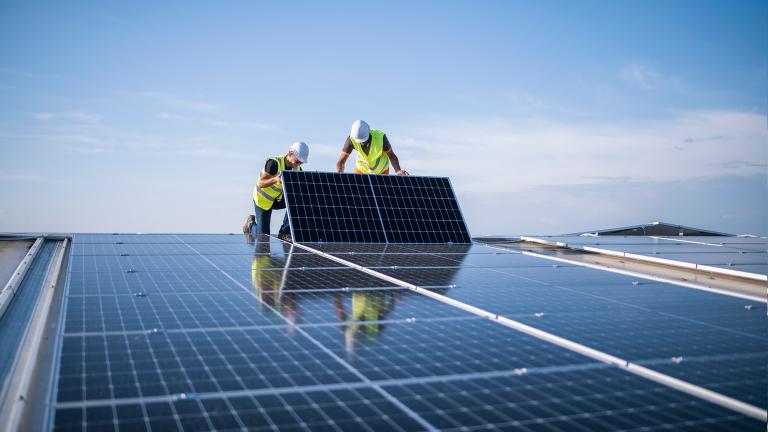If we want to stabilize atmospheric CO2 at 450 ppm around 2050 — the minimum necessary, which still might carry major impacts — we need to achieve at least 2 percent average annual net reductions in emissions, globally, starting in two years. Not only do the near term emissions reductions matter the most, but it will get easier, not harder, as we go along. Solar PV and solar thermal are likely to become cheaper than new coal plants in a decade or so. They will also probably become cheaper than wind around the same time, and together these resources will make it possible to eliminate about three quarters of fossil generation.
It may be possible to exceed the 2 percent rate. But the only way to know that is to achieve 2 percent first. Nothing weaker than 2 percent is particularly worth talking about, and anything stronger is very hard to achieve. Also, any strategy to reduce CO2 emissions must address ongoing growth. While there are many reasons to believe the rate of new growth will change, as it has done historically, it is at present about 1.5 percent per year. Thus a 2 percent annual net reduction in today’s world means a 3.5 percent gross reduction.
This series discusses the implications of this goal for the U.S. electric industry.
Based on available response technologies, it is clear that a steady annual rate of emissions reductions is more practical than any alternative. Our ability to respond to global warming is constrained by the rate at which we build things. We can make every new residential and commercial building a zero energy building, but we can’t build them at twice the normal rate. We can build renewable technologies, but we can’t expect to build manufacturing facilities to replace the entire nation’s electric supply in five or ten years — that will result in a huge investment in factories that will become idle in five or ten years. It is true that solving global warming is serious enough that we ought not be bound by conventional economic perspectives, but it is not true that we can create a national consensus to do the massively dramatic stuff faster than we can get the ball rolling with conventional fiscal prudence. First things first.
Efficiency potential is large enough to permit net reductions today. It’s hard to measure a negawatt, but not impossible to make good estimates of the real efficiency potential. By one informed account [PDF], energy efficiency has been responsible for 77 percent of all new energy resources added to the U.S. economy since 1970. Even a simplistic approach, dividing energy consumption by Gross Domestic Product, suggests that efficiency has produced half of all new energy resources since then.
Utility or end-use efficiency programs are being run in three states, at about 2 percent of load displacement per year. Since the nation’s electric consumption grows at something less than 1.5 percent per year, these programs have the potential to eliminate all new growth, but not to cause a net reduction of 2 percent per year. However, by aggressively pursuing waste energy through technologies like combined heat and power (capturing waste heat from industrial processes and generating electricity, or alternately, capturing the waste heat from electric generation and using it to displace fossil fuel used for heat or process steam), it is a simple matter to identify a strategy which could cause 2 percent net reductions in electric sector emissions within a couple of years.
Many people argue that efficiency reduces energy costs and therefore increases consumption. The principle is real, but a much smaller factor than would be required to overcome the ongoing global shift in energy prices in 2008. In the 1980s, the full implementation of the U.S. CAFE standards coincided with a global glut of energy production caused by massive investment in new production facilities. This led some people to believe that efficiency caused low prices and therefore increased consumption, but it is unrealistic to expect a repeat of those circumstances.
—
If we take an economic dispatch approach to solving climate change — meaning we do the cheap stuff most aggressively and first — it is unlikely we will ever need nuclear power or carbon sequestration. A number of reports have produced carbon free resource graphs like the one below from TVA [PDF]:

This particular graph assigns an unrealistically low cost to new nuclear power plants (it is probably pretty on-target for repowering existing nukes, particularly the TVA nukes). It also grossly underestimates potential for carbon reduction from building shell insulation and heat transfer modifications, which have the potential to eliminate about half of all CO2 in the U.S. using cost-effective means in this sector alone.
Rarely mentioned is the fact that if we increase spending on low-cost resources to the levels presently justified by the current economic benefits of those resources, we will increase the availability and reduce the cost of those resources. If we invest like we ought to in solutions beneath the line, we may never need those above the line.
This is particularly true in light of the likely cost paths of solar photovoltaics and solar thermal on one side, and coal, nuclear, post-combustion carbon sequestration, and natural gas on the other. New wind is already marginally cheaper than new coal, but wind may have a hard time reducing price substantially in the future. Solar PV and thermal have much potential to reduce cost, and the other resources are all likely to be come even more expensive.
We need to move aggressively on the cheapest options, and they are almost all efficiency.
Wind:
Last year, the renewable industry added only about 20 percent of new growth. Wind exceeded 1 percent of total U.S. electric generation in 2007, but that is the output of several decades’ worth of wind construction. Even if you assume wind will grow at 35 percent per year, it will still be the better part of a decade before wind is large enough to offset new growth. We need this, of course, but wind will slam into a wall when it is no longer replacing new consumption, but instead being compared to the cost of displacement of electricity from existing coal plants.
There has been much glib discussion of massive increases in transmission capacity to allow wind service. But a comprehensive solution to global warming in the electric sector is likely to require a strong enough efficiency response that transmission resources for wind are not a core issue for several decades. Transmission capacity is expensive and will knock wind out of the running in situations where the wind resources are not reasonably local. Just as a 20-40 percent premium for nuclear power or carbon sequestration makes a vast array of efficiency alternatives available, and a better deal, so does adding new wind plus a long distance transmission line.
Perhaps the lesson here is that the whole climate response is so complex that we can’t expect to envision it well or properly until we have started with the low hanging fruit.
Electric cars and wind:
One of the muted joys of being an efficiency advocate is the frequency with which one is proven right. The biofuels mess was predictable, just as the current price of gas was predictable in 1982 when the Reagan administration tried to roll back CAFE standards and successfully blocked the NHTSA’s legal responsibility to increase the standards in response to the cost-effectiveness of the efficiency gains. There are no meaningful renewable alternatives to petroleum or natural gas, unless the electric car proves viable. Synfuels may not fly in the long run, but they seem to have some economic justification, and therefore present a massive potential increase in CO2.
The electric car is potentially less CO2-intensive than gasoline, even using 100 percent coal to fuel it, but there is another aspect: If you recognize that electricity is far cheaper than gasoline for an equivalent distance driven, it suggests a possible solution for the moment when wind development runs into the economic hurdle of displacing much cheaper coal in existing power plants.
Fueling an electric car is so much cheaper than fueling a gasoline car that it should be possible to build a subsidy for wind turbines into the price of an electric car without the buyer being aware — unless the manufacturer chooses to make it a marketing tool. A reasonable estimate of the cost of wind capacity to fuel an electric car is $425/year. This is just an estimate, without reference to any specific wind turbine or electric car. Using plug power would cost less (perhaps $360) at today’s average rates, but plug power includes generation resources which were amortized decades ago.
An electric car owner would use plug power, but would not need to pay the entire cost of a new wind turbine to ensure that the entire fuel resource used by his or her car was offset by renewable resources. Rather, the manufacturer of the electric car could include a fee in the price of the car which would subsidize the construction of new wind turbines. Adding this new subsidy to the existing federal tax credit would make a very attractive offer to utilities considering new wind resources, at a small fraction of the full cost of the new wind.
This is not just a gratuitous marketing scheme — it is the best suggestion I have heard to date to keep the wind industry moving ahead at the point that we stop building wind to meet new growth in electric consumption, and start trying to build it in the face of net reductions in electricity consumption and/or CO2 emissions.


